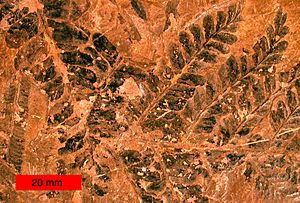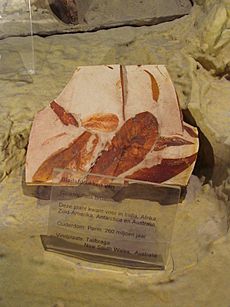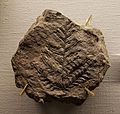Seed fern facts for kids
Quick facts for kids Pteridospermatophyta |
|
|---|---|
 |
|
| Fossil seed fern leaves from the Pennsylvanian Carboniferous of northeastern Ohio. | |
| Scientific classification | |
| Kingdom: | |
| Division: |
Pteridospermatophyta
|

The term seed ferns (Pteridospermatophyta) refers to several different groups of extinct seed plants. These plants are no longer alive today. They looked a bit like ferns but reproduced using seeds, not spores.
The oldest fossils of seed ferns come from ancient rock layers from the Devonian period. They were very common during the Carboniferous period and the Permian period.
Seed ferns became less common during the Mesozoic Era. Most of them had disappeared by the end of the Cretaceous period. However, some plants that looked like seed ferns might have lived into the Eocene period in Tasmania.
What Are Seed Ferns?
The idea of seed ferns started in the late 1800s. Scientists who studied ancient plants, called palaeobotanists, noticed something interesting. Many Carboniferous fossils looked like fern leaves. But they also had parts that were like cycads, which are seed plants.
British palaeobotanists made an important discovery. They found that some of these fern-like leaves were connected to seeds. This meant the leaves and seeds came from the same plants.
At first, people thought these plants were somewhere between ferns and cycads. That's why they were called "seed ferns" or "pteridosperms." Today, most palaeobotanists believe seed ferns are not closely related to modern ferns. So, these names can be a bit confusing, but they are still used.
Why the Name "Seed Ferns" Stuck
Later in the 1900s, the idea of seed ferns grew to include many Mesozoic seed plants. These plants also had fern-like leaves. Some scientists even included seed plants with whole, undivided leaves, like Glossopteris. This made the term very broad.
Seed ferns were some of the very first seed plants on Earth. They likely included the ancestors of many later plant groups. They are found in many different plant families. Because of this, many palaeobotanists today see "seed ferns" as more of a general group. It describes plants that share some features but are not necessarily a single family.
So, is the term "seed ferns" still useful? Yes, it is! Many palaeobotanists still use the term in an informal way. They use it for extinct seed plants that are not flowering plants, conifers, ginkgos, or cycads.
This is especially helpful for extinct seed plant groups whose exact relationships are not known. We can call them seed ferns without saying they are all from one specific family. Also, for museum curators or collectors, "pteridosperm" is a quick way to describe fern-like leaves. These leaves were probably made by seed plants and are often found in Palaeozoic and Mesozoic fossil collections.
Images for kids
See also
 In Spanish: Pteridospermas para niños
In Spanish: Pteridospermas para niños


